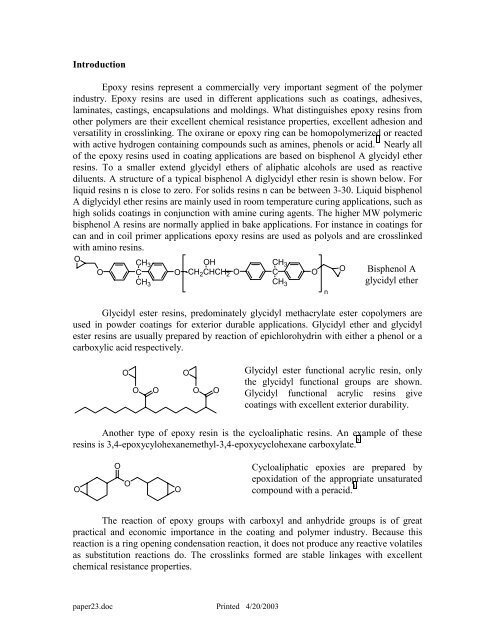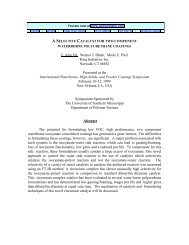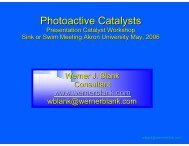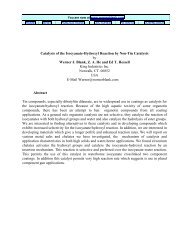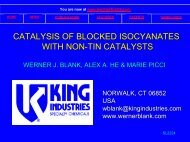Catalysis of the Epoxy-Carboxyl Reaction - Werner Blank
Catalysis of the Epoxy-Carboxyl Reaction - Werner Blank
Catalysis of the Epoxy-Carboxyl Reaction - Werner Blank
You also want an ePaper? Increase the reach of your titles
YUMPU automatically turns print PDFs into web optimized ePapers that Google loves.
Introduction<br />
<strong>Epoxy</strong> resins represent a commercially very important segment <strong>of</strong> <strong>the</strong> polymer<br />
industry. <strong>Epoxy</strong> resins are used in different applications such as coatings, adhesives,<br />
laminates, castings, encapsulations and moldings. What distinguishes epoxy resins from<br />
o<strong>the</strong>r polymers are <strong>the</strong>ir excellent chemical resistance properties, excellent adhesion and<br />
versatility in crosslinking. The oxirane or epoxy ring can be homopolymerized or reacted<br />
with active hydrogen containing compounds such as amines, phenols or acid. 1 Nearly all<br />
<strong>of</strong> <strong>the</strong> epoxy resins used in coating applications are based on bisphenol A glycidyl e<strong>the</strong>r<br />
resins. To a smaller extend glycidyl e<strong>the</strong>rs <strong>of</strong> aliphatic alcohols are used as reactive<br />
diluents. A structure <strong>of</strong> a typical bisphenol A diglycidyl e<strong>the</strong>r resin is shown below. For<br />
liquid resins n is close to zero. For solids resins n can be between 3-30. Liquid bisphenol<br />
A diglycidyl e<strong>the</strong>r resins are mainly used in room temperature curing applications, such as<br />
high solids coatings in conjunction with amine curing agents. The higher MW polymeric<br />
bisphenol A resins are normally applied in bake applications. For instance in coatings for<br />
can and in coil primer applications epoxy resins are used as polyols and are crosslinked<br />
with amino resins.<br />
O<br />
O<br />
CH 3<br />
C O<br />
CH 3<br />
OH<br />
-CH2CHCH2 paper23.doc Printed 4/20/2003<br />
O<br />
CH 3<br />
C O<br />
CH 3<br />
n<br />
O<br />
Bisphenol A<br />
glycidyl e<strong>the</strong>r<br />
Glycidyl ester resins, predominately glycidyl methacrylate ester copolymers are<br />
used in powder coatings for exterior durable applications. Glycidyl e<strong>the</strong>r and glycidyl<br />
ester resins are usually prepared by reaction <strong>of</strong> epichlorohydrin with ei<strong>the</strong>r a phenol or a<br />
carboxylic acid respectively.<br />
O<br />
O<br />
O<br />
O<br />
O O<br />
Glycidyl ester functional acrylic resin, only<br />
<strong>the</strong> glycidyl functional groups are shown.<br />
Glycidyl functional acrylic resins give<br />
coatings with excellent exterior durability.<br />
Ano<strong>the</strong>r type <strong>of</strong> epoxy resin is <strong>the</strong> cycloaliphatic resins. An example <strong>of</strong> <strong>the</strong>se<br />
resins is 3,4-epoxycylohexanemethyl-3,4-epoxycyclohexane carboxylate. 2<br />
O<br />
O<br />
O<br />
O<br />
Cycloaliphatic epoxies are prepared by<br />
epoxidation <strong>of</strong> <strong>the</strong> appropriate unsaturated<br />
compound with a peracid. 3<br />
The reaction <strong>of</strong> epoxy groups with carboxyl and anhydride groups is <strong>of</strong> great<br />
practical and economic importance in <strong>the</strong> coating and polymer industry. Because this<br />
reaction is a ring opening condensation reaction, it does not produce any reactive volatiles<br />
as substitution reactions do. The crosslinks formed are stable linkages with excellent<br />
chemical resistance properties.


